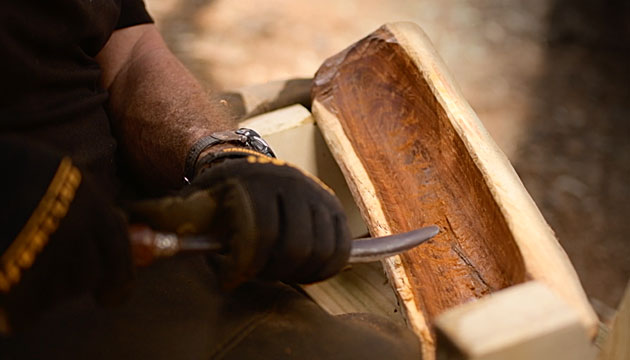Traditional crafts and cultures of the Flinders Ranges are enlivened in the Yurtu Ardla exhibition at the South Australian Museum.
Story Mark Muller Photo Dave Laslett
The hard thwack of an axe striking wood cuts through the soft light of a muted exhibition space in the South Australian Museum. Artist and curator Dr Jared Thomas smiles as he walks further into the room. Around a corner two people are watching a large screen. On it is projected a film in which Jared and a group of his family and friends work on the carvings and objects that are now a significant part of the Yurtu Ardla exhibition.
Yurtu Ardla means wood in the Nukunu and Adnyamathanha languages, respectively. The exhibition is a combination of carved objects, videos and stills photography that together tell the story of the artists, their country and the cultural continuity at the heart of this endeavour.
“It involves my own Nukunu family of the Southern Flinders Ranges, including my father, uncles and cousins, and Adnyamathanha men from the northern Flinders and Gammon ranges,” Jared says. It is the first exhibition he has curated in his relatively new role as the museum’s William and Margaret Geary curator of Aboriginal and Torres Strait Islander art and material culture.
The project began with the grassroots desire of men in Port Augusta to work with and learn from Adnyamathanha elder and master carver Roy Coulthard. Ku Arts – the South Australian support organisation for Aboriginal art centres and artists – came on board and has supported Yurtu Ardla as it has grown and morphed throughout the past five years.
“We’re the same cultural block,” Jared says. “We have the same law and similar culture and traditions, but being deeper into the Flinders Ranges and therefore a bit more buffered from the impact of colonisation, the Adnyamathanha were able to keep a tighter hold on their heritage.
“Over the past 20 years there’s been some conflict,” Jared says. “People have been protective of their knowledge, particularly when that knowledge can play into the space of Native Title – we share boundaries and there have been disagreements around where the boundaries are, but I’m focused on helping people from neighbouring groups to work together and look for wider outcomes.”
Some of the objects in the exhibition – such as a yakadi (walking stick) attributed to Roy’s grandfather Ted Coulthard – date back more than a century. Others are new thiparra (shields), ngarla wirri (digging stick/clubs), piti (coolamon) and wadna (boomerangs) produced as part of the project. All are informed by tens of thousands of year of culture.
“When I was young in Nepabunna my dad made a lot of these artefacts,” Roy says down the phone from Leigh Creek, where he has been conducting a workshop with local school children. “They may be for survival and for protection. And it really meant a lot to the old people. When I wanted to give up a heap of times Dad said, ‘No way, keep doing it and then you got to teach your kids and they’ll teach their kids and it must go on’.” Indeed, two of Roy’s grandsons – Clayton Cruse and Dallas Brady – have work in the exhibition.
From the initial workshops in Port Augusta sprang an engagement with the museum and a request to visit the organisation’s Netley facility, where the bulk of the museum’s 30,000 Aboriginal objects are stored. There were only 16 pieces of Nukunu origin. That in itself fanned the need to take things further.
The workshops were then extended to included bush camps on Nukunu and Adnyamathanha country, the Adelaide-based Mobile Language Team was folded in, and Port Augusta photographer and filmmaker Dave Laslett was engaged. The local men were also happy to include Gumbaynggir man Troy Dargan, from NSW.
Jared’s father Darryl Thomas works with Roy in schools, and has been a part of the project since its inception. He felt the weight and also the joy of being able to engage with the Netley material, and to spend time working on country.
“That was really great,” Darryl says. “You can be on your country and doing something and you know that your grandfather was there before you. You become connected, not only to the environment but also to your grandfathers. To hold some of those old objects in my hands – I could feel the spirit. It was in the wood. You get that sense of energy and you take that spirit into the work.”
Ku Arts CEO Marie Falcinella believes Yurtu Ardla is a strong example of how responsive involvement can create pathways to broader opportunities. “It’s important to see how things can start from small engagements,” she says. “Ku’s work starts in the community. By seeing what interest there is and in working out how we can create programs and workshops that support those interests, we can help create transformative projects.”
“I’m really happy that our things are there [in the museum],” Roy says. “I’m grateful that my dad did keep me going or we could’ve lost everything and this country would’ve been nothing to us. It would’ve been a country here but we wouldn’t know what it meant.
“There are people who say we should get our stuff back up here. Where? It’s good to have a person like Jared down there looking after our things. It’s important.”
Later, the couple that was watching the screen approach Jared shyly. They are Canadians and are rapt with the exhibition.
“I heard your voice on the film,” says the woman, who shares that she herself is indigenous. “Then I was hearing you in here. I just had to say hello. It’s wonderful!”
Yurtu Ardla is at the South Australian Museum until June 16, after which it is hoped the exhibition will travel to Port Augusta. For more, visit yurtuardla.com.au
This story excerpt is from Issue #125
Outback Magazine: June/July 2019










